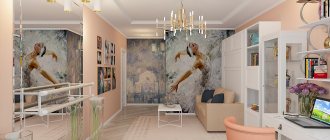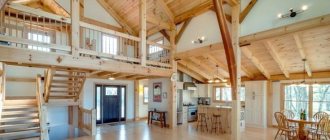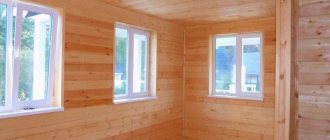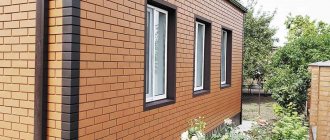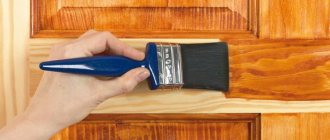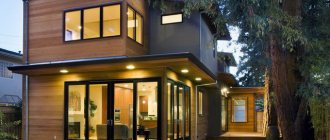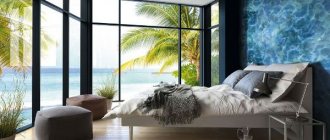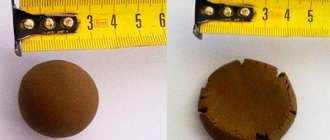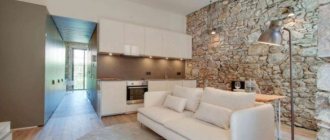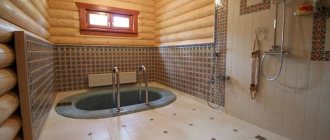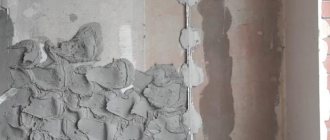Are you planning to move into a modern frame house and are waiting for the completion of construction? Spend this time usefully and learn the most important things about interior decoration in the Kvartblog tips.
Moreover, you can completely take control of this stage or perform it yourself. It is enough to choose materials that will create a pleasant microclimate in a frame building and follow standard work technology.
Let's talk about this in detail.
What you need to know about finishing
Since internal cladding is the final stage of construction, when doing it yourself, it is important to understand several rules:
- The decoration of the walls of the premises is carried out one by one; there is no point in starting work everywhere at the same time;
- Activities to sheathe the walls must begin from the back room;
- It is necessary to carry out work on completion of construction with your own hands after laying all communications - water supply, electrical cables, etc.;
- All finishing work is carried out from top to bottom, starting from the ceiling, then sheathing the walls with slabs and ending with the floor, the exception is the option with a stretch ceiling, which is formed last;
- It is important to cover all furniture and areas not related to repairs with polyethylene.
In order for DIY indoor activities to be completed in a short time, the following is required:
- Stock up on all necessary materials;
- Fully familiarize yourself with the nuances of the selected design type;
- Weigh the possibilities of your budget;
- Try to exclude the occurrence of any force majeure circumstances.
On average, if you have experience and everything necessary, the interior decoration of a small frame house will take a month. A larger house will require attention within 1.5 - 2 months. But for a house with 2 floors, 2-3 months of work are needed.
How to insulate a frame
To insulate the walls of a frame house, you need to select a heat-insulating material, determine its sufficient thickness, and choose an installation technology. And also use a flexible approach in choosing the material for the internal walls that will cover the insulation. Then complete the interior wall finishing of the houses.
Finishing frame houses with high-quality materials.
This technology determines the general sequence of actions for assembling the wall of a house. When using various insulation materials, features are added to the general technology; each method has nuances. The technology for insulating the frame is determined by the material of the heat insulator.
A frame house can be insulated with mineral wool and does not require fasteners. Due to its ability to compress, mineral wool is placed between the supports and is well held between them. They work differently with polystyrene foam. When using it, insulation sheets must be fixed. It is also necessary to blow out the resulting cracks with foam.
Let's talk about how to properly insulate the frame of a house, what technology to use for high-quality finishing of houses. And also about what is better to insulate a frame house - mineral wool, polystyrene foam or other insulators - cork, ecowool.
What to apply
Today there are many proposals for carrying out facing activities. For the initial design of walls, plasterboard, OSB and chipboard are most often used. For the most part, they are used because of the ability to hide wall imperfections or implement complex design ideas.
Important: OSB, plasterboard and chipboard allow you to sheathe walls in a short time and begin finishing work without delay, especially since chipboard makes it possible to use suspended structures.
- To complete the final work, you can use wallpaper to cover the walls. On the modern market they are presented in various types and with different designs.
- Ceramic tiles - they have excellent decorative characteristics and have a long service life. To cover walls with this material, they must first be covered with plasterboard.
- Lining or chipboard - due to their decorative qualities and natural components, they are an indispensable material for country houses. If you cover the walls with this material, they will give strength to the frame house from the inside.
- Liquid wallpaper - in the design of walls is of particular value because of its texture and decorative effect;
- Decorative plaster – has excellent fire resistance, resistance to mechanical damage, and an optimal pricing policy.
- Flexible stone - produced for wall decoration in rolls and slabs, has the properties of decorative stone, but at the same time has flexibility and wear resistance
Before starting work with your own hands, you should:
- Stock up on the necessary tools;
- Clearly mark the placement of sockets and switches;
- Take precautions.
Insulation of buildings with mineral wool
The simplest insulation of the frame with your own hands is done using mineral wool. In addition, cotton insulation has an advantage over polystyrene foam. It allows air to pass through, which affects the environmental friendliness of housing. In a properly built frame house there is no smell of mold or dampness.
Insulation with mineral wool for finishing.
To insulate frames, roll wool and so-called slabs or mats are used. Mats differ from rolled material in being more dense and rigid. While maintaining their spring properties, they work better in a vertical position, settle less and do not cake. Therefore, their use for insulating vertical walls is preferable to rolled wool.
On a note
Mineral wool has replaced traditional glass wool. It is made from molten stone. The resulting liquid mass is spun in a centrifuge and long fibers are obtained.
Therefore, mineral wool, like glass wool, contains small stone needles. The presence of stone components imposes certain safety requirements for working with this material. It is necessary to protect the respiratory system with a respirator to prevent small needle-like particles from entering the respiratory tract.
Insulation technology and vapor barrier
When working with cotton insulation, use the following installation technology:
- During construction and design, choose the pitch of frame supports corresponding to the length and width of the selected slabs or the width of the rolled wool. The distance between the supports should be less than the size of the cotton insulation.
- If the wall is insulated with rolled wool, it is unpacked and cut to size with special scissors. If the wall is insulated with slabs and mats, they are used in finished form; if necessary, they are cut with a special knife or saw. When working, use protective gloves and a respirator, and wear long sleeves.
- The insulation is placed between the supports after slight squeezing and compression.
- A membrane material is placed on the outside of the insulation. It is undesirable to use ordinary polyethylene instead of membrane vapor barrier. Polyethylene film does not have the necessary structure and does not allow vapor molecules to escape.
- On the inside, the insulation is covered with a vapor barrier. Thus, it is protected from possible dampness, while maintaining its “breathing” properties. Cotton insulation must be protected from moisture. When damp, cotton insulation loses its heat-insulating properties. Therefore, the mineral insulation is closed on both sides, from any dampness.
- On the inside, the insulation and vapor barrier are covered with wall sheathing, on top of which the wall finishing of the house is performed.
Mineral wool is twice as expensive as polystyrene foam. Therefore, in individual construction, a less suitable material is often preferred to cotton insulation - foamed polystyrene, known as polystyrene foam.
Using drywall
This material has a number of advantages for wall cladding:
- The ability to hide all the unevenness of the wall;
- Availability of hiding communication nodes;
- Ease and speed of installation;
- The lightness of the material itself.
To lay drywall on the surface you need to go through several steps:
- Hide communications in a plastic pipe;
- Apply insulation;
- Install profiles and attach sheets to them;
- Fill the seams between the sheets with putty and sand them.
Thickness of frame walls depending on climate
When calculating the thickness of the walls in a frame house, you need to take into account the climate of the region in which the house is being built. For example, in an area with warm winters and hot summers, the thickness of the structure may be minimal. In areas with a cold climate, walls need to be insulated better.
How warm the house will be depends on the thickness of the insulation of the frame house. This thickness can be calculated by multiplying the thermal resistance of a specific area by the thermal conductivity of the selected material.
Each specific locality in Russia has its own thermal resistance indicator. It can be viewed on the website of building codes and regulations of the Russian Federation.
How warm the house will be depends on the thickness of the insulation of the frame house.
Application of OSB
If the house is frame, you should use stronger fasteners than with plasterboard, since OSB is a heavy board. The technology of wall cladding itself is not much different from the previous one.
In order to lay OSB boards with your own hands, you should take into account certain nuances:
- To attach OSB to a wooden frame, use spiral nails 50 mm long;
- At the joints they must be driven in at intervals of 15 cm;
- Along the edge to the edge of the walls, it is necessary to form gaps of 1 cm; if the OSB boards do not have a connection, the distance between them should be 2 mm;
- After installing the OSB, it must be plastered with fine-grained sandpaper;
- If OSB is to be coated with paint, the panel should initially be primed.
Important: the OSB board should be varnished 3 times to protect it from moisture and fungus.
Care Tips
In a house with wooden walls, the interior decoration may deteriorate faster than usual. A frame house is a building made of wood, so it is especially important to take care of the ventilation and water purification systems, treat existing wooden coverings and prevent the appearance of parasites, fungus and mold.
If the house is without interior decoration, fire-fighting agents and substances against insects should be applied to the wooden elements. If there is high dampness in the room, for prevention you can coat surfaces with disinfectants and antibacterial agents.
Wood panels
The use of chipboard is due to the strength, reliability and low cost of the board.
The reasons for the popularity of using chipboard are obvious:
- Complete cleanliness of the installation;
- Resistance to high room humidity due to formaldehyde resins;
- High decorative qualities, which makes it possible to use chipboard in public institutions for finishing cladding;
Important: today chipboard is produced that is suitable for decorating glazed loggias and balconies.
Wallpaper and plaster
Decorative plaster is an excellent option for covering surfaces in the kitchen, as it is not afraid of moisture and is easy to clean. It can be washed with water and soapy water.
Paintable wallpaper has the advantage of being able to update the interior by applying new paint to the old one. They can also be used to create a seamless application of the material due to its texture.
Important: before applying paint, they must sit for 24 hours.
Construction of houses
0 votes
+
Vote for!
—
Vote against!
It would seem that the house has been built. However, it is not suitable for housing, as it still resembles an empty box. In order to give the room a residential and cozy look, it needs further finishing, both external and internal. The interior finishing of a frame house itself is divided into two stages: rough work and final finishing. Each of the stages is important in its own way and we will tell you about them in more detail.
Table of contents:
- What is meant by interior decoration?
- What materials are used?
- Where does the interior decoration of a frame house begin?
- Plasterboard finishing: features
- Finishing with OSB boards
- Plaster and wallpaper for painting
- Application of lining and imitation timber
What is meant by interior decoration?
Interior decoration of the house allows you to give the room not only a finished look, but also to bring repairs or construction to its logical conclusion. Depending on the task at hand, the actions vary. For example, if renovations were carried out inside an already built room, then it is not necessary to carry out rough finishing work.
There are several rules that you should rely on if you want to do the interior decoration of your home yourself:
- The finishing of the room is carried out progressively as it progresses. It is not recommended to start finishing work in all rooms at once,
- if there are several rooms, then the renovation first begins in the room farthest from the front door,
- all finishing work is carried out after new communications have been replaced or laid, such as cable ducts, water pipes and electrical cables,
- repairs are carried out “from top to bottom”: first, work is carried out on the ceiling, then the interior walls of the house are finished. Next comes the floor. The exception is the case when suspended ceilings are used in a frame house. In this case, the ceiling is attached last.
- It would be advisable to cover all areas of the room not involved in finishing with thick plastic film to protect surfaces from contamination and construction debris.
As a rule, the speed of finishing is also influenced by several factors:
- the complexity of finishing the room,
- timely delivery of materials,
- budget,
- force majeure circumstances.
On average, the interior decoration of a small house with an area of 40 m2 can take a month, with an area of 60 m2 already 1.5-2 months, and the complex decoration of a multi-storey building will require 3 months of work. For the most part, the timing of the work depends on the qualifications of the invited construction team. Many companies offer turnkey frame house projects, and all work, from preparing the foundation to handing over the keys to the owners, takes no more than two months. If you want to carry out the finishing yourself, you must take into account that without the proper amount of free time, repairs can drag on for years. It is not for nothing that they say that “repairs do not end, they are suspended.”
Rough finishing of a house includes measures to prepare the surface of walls, floors and ceilings for finishing work. Such measures include removing old or poor-quality coatings, preparing and leveling surfaces, screeding floors and installing slopes on windows.
Finishing is the final stages of finishing work, when the walls and ceiling are painted or wallpapered, or finished with facing materials.
The use of natural wood lining will have a beneficial effect not only on the aesthetics of the interior, but also on the microclimate prevailing inside the room. Moreover, the combination of cedar and linden wood will reduce the frequency of headaches. Properly selected finishing materials will allow you to change the interior beyond recognition in the shortest possible time.
What materials are used?
The modern materials market offers many different solutions to suit every taste. Basically, it all depends on the allocated budget and personal preferences. For rough finishing, sheets of plasterboard and OSB are often used. Their advantage is that the flat surface of the sheet allows you to hide wall imperfections, such as:
- curved or untreated wall surface,
- the need to install an internal partition,
- implementation of complex design compositions,
These materials will allow you to quickly cover the internal walls and prepare them for further finishing and finishing work. The following materials are used for finishing:
- Wallpaper. The following varieties are available on the market:
- traditional paper ones. They are distinguished by their low price, but at the same time they are often aesthetically unattractive, are not resistant to moisture and cold, and are short-lived. Well suited for pasting walls of non-residential premises, or as a temporary solution,
- vinyl varieties are characterized by increased strength and resistance to mechanical damage,
- acrylic wallpaper is good for its moisture resistance and durability,
- non-woven wallpaper made of foam vinyl is more often used as a base for applying decorative paint,
- Fiberglass wallpaper is characterized by high fire safety and mechanical strength. Moreover, they are suitable for painting walls,
- Photo wallpapers are notable for the fact that they allow you to recreate a kind of “living” corner inside the house.
- Ceramic tiles for cladding. It is good because it is characterized by high wear resistance and a high degree of decorativeness. At the same time, it requires a perfectly flat surface. It is advisable to mount it on drywall, or on a carefully leveled wall surface. The good thing about tiles is that there are many textured varieties on the market that perfectly imitate various surfaces: from brick to natural stone.
- Lining made of natural wood will bring a natural look and home comfort to the room. In addition, wood has high heat and sound insulation characteristics. Experts divide types of lining into categories based on the quality of the final product:
- “Extra” grade means a high quality product, without surface defects,
- grade “A” allows for the presence of small darkened spots and chips in the lamellas,
- grade “B” means that there are several knots and cracks on one lamella,
- grade “C” is notable for its low price, while the wood slats often have surface defects such as cracks, knots, resin bags and dark spots.
On the other hand, when creating a vintage setting, such slats will give the room a more attractive antique look.
- Plastic lining is characterized by its low price and ease of installation. Plastic or PVC are not susceptible to biological activity, but at the same time they are not able to bring real comfort to the room. The artificiality of the material is immediately noticeable to the eye. Their heat and sound insulation characteristics are inferior to similar models made of natural wood, but the advantages of PVC for finishing have made the material so popular.
- Liquid wallpaper is a dry mixture of a binder and cotton or cellulose fibers. This type of wallpaper is successful in that it allows you to hide defects in the surface on which it was applied. In addition, due to its texture, liquid wallpaper is valuable for its decorative properties.
- Decorative plaster is known for its fire-resistant and mechanical properties. At the same time, it is easy to apply, and the final cost is not high.
- Magnesium glass sheets are a fairly new material. It consists of wood shavings, fiberglass mesh and chemical additives. This material is fire-resistant and moisture-resistant, while providing good adhesion to almost any applied material.
- Flexible stone combines all the advantages of natural stone, but at the same time has ductility and flexibility. This material is produced in the form of wallpaper and decorative panels. It is characterized by ease of installation and wear resistance, along with high environmental friendliness and resistance to external factors.
Where does the interior decoration of a frame house begin?
Any work begins with the preparatory stages. After all communication systems have been installed and laid, you must first decide on the location of sockets, switches and plumbing system outlets. Further work is carried out depending on the material used.
First you need to stock up on a tool that is in demand in any situation:
- roulette,
- putty knife,
- building level,
At the same time, it is also worth remembering that any work requires the proper degree of protection. Glasses with polycarbonate lenses will protect your eyes from construction particles, and good durable gloves will protect your hands from possible cuts.
Plasterboard finishing: features
Drywall is good because it allows you to hide all the unevenness of any surface. In this case, there is no need to perform labor-intensive leveling of the walls due to the fact that the plasterboard sheets are attached to a metal frame. The work itself on installing the sheets is carried out quickly.
At the same time, the material demonstrates another advantage: the free space between the sheet and the wall allows you to hide cable channels with electrical wiring there. Among other things, the low weight of plasterboard sheets does not create a significant load on the floors, and thanks to this, complex geometric structures are constructed, including even multi-level ceilings.
If the frame house inside is an unfurnished home, then the decision to use plasterboard for interior decoration will be correct.
The installation of sheets itself is divided into several stages:
- starting UD profiles are attached along the intended line using self-tapping screws,
- the wiring is laid in special plastic boxes or corrugated flexible PVC pipes,
- free space, if necessary, is filled with insulation,
- sheets of plasterboard are laid on the profile and attached to it with metal screws. In this case, the head of the screw must be recessed at least 1 mm deep,
- The seams between the sheets are filled with putty. In this case, excess material is removed with a spatula and the seams are aligned,
- after that, using fine-grained sandpaper, all joints are sanded and the surface of the plasterboard sheet is ready for finishing and applying any selected material to it.
Finishing with OSB boards
The installation of such boards itself is not much different from the process of sheathing with plasterboard, with the only difference being that OSB boards have significantly more weight. Therefore, finishing a frame house with such material will require more durable and reliable fasteners.
When laying slabs, it is worth considering the following features:
- Spiral nails 50 mm long are used to fasten the boards to the wooden frame,
- at the joints, nails are driven in every 15 cm,
- Gaps of 1 cm should be left along the edges to the edge of the walls, the distance between slabs that do not have a connection should be no more than 2 mm,
- OSB sheets are laid on the floor perpendicular to the joists,
- After fastening, it is recommended to sand the surface of the slab using fine-grained sandpaper,
- It is also recommended to varnish the slabs in three layers, with careful and natural drying of each applied layer. This coating will protect the structure of the material from possible penetration of moisture,
If you plan to cover the surface of the OSB board with paint or plaster, then in this case you will need to prime it first.
Plaster and wallpaper for painting
Decorative plaster for interior decoration of a house, photos of which are provided below, is an excellent option. This material will hide wall defects and unevenness.
It is good because it is not afraid of moisture and does not absorb soot and odors, which is especially valuable for the kitchen. In addition, the plaster can be washed.
Paintable wallpaper is good because it allows you to completely change the interior over time, without resorting to significant expenses. To do this, it is enough to repaint them, covering the old one with a layer of new paint. In addition, wallpaper for painting often has a texture, allowing you to create a uniform and seamless surface.
The gluing of such wallpaper itself is no different from gluing simple wallpaper, with the difference that after gluing the wallpaper you need to give it a day before applying paint to it.
Application of lining and imitation timber
Many types of lining are interesting because they can recreate a full-fledged imitation of wood, which is especially important for country houses. The presence of wood resins will allow the timber to maintain its durability and other properties.
At the same time, the price for such material is affordable and affordable even for small budgets. Especially if you purchase “C” grade lining, which, despite the defective surface, will bring a vintage feel to the interior of a country house.
The price for high-quality lining starts from $8 for a lamella 4 m long and 10 cm wide.
Wood simulants are good for their environmental friendliness and durability. Thanks to heat treatment, the lining does not crack over time and does not lose its quality. Therefore, this material will remain attractive for a long time in the eyes of many owners of country houses who have decided to carry out interior decoration with this particular material.
Installing tiles
The technology for installing tiles is not at all difficult, although it has a number of nuances:
- An adhesive composition should be applied to the primed surface, and the tiles are applied to it;
- The position of the part is checked using a level; if certain errors are present, tap it on its surface with a rubber hammer. To perform uniform jointing, it is necessary to install crosses between the products;
- After installation is completed, it is necessary to sand the seams and clean the surface of the tile from glue.
